Honest Money Financial Markets Wrap - Stocks, Commodities and Gold
Stock-Markets / Financial Markets Jun 04, 2007 - 12:17 AM GMTBy: Douglas_V_Gnazzo
Economy
The Reuters/University of Michigan's final index of consumer sentiment increased to 88.3 in May, from 87.1 in April.
The Institute for Supply Management's factory index rose to 55 in May, from 54.7 in April.
The National Association of Realtors reported that pending home resales fell 3.2% to 101.4, the lowest since February 2003. The March report was revised down 4.5%. The index is down 10.2% from April 2006.
Rising mortgage defaults are increasing the supply of houses for sale. Banks and other lenders are raising their lending standards, resulting in home purchases being less affordable to fewer buyers.
Late payments on subprime mortgages drove up U.S. foreclosure filings in the first quarter of 2007 by 35%. This is making it harder for potential buyers to get loans, as lenders are becoming more cautious.
As a result homebuilders are cutting staff as sales drop. Pulte Homes is letting go of 16% of its staff, further reducing its workforce that has been cut by a quarter since the housing slowdown began.
GDP Grew 0.6% in First Quarter
The economy grew at an annual rate of 0.6 percent in the first quarter, according to the "preliminary" estimates released by the Bureau of Economic Analysis. Based on newly available data that showed a marked reduction in business inventories and a surge in imports in March, the GDP growth rate was revised down 0.7 percentage points from the "advance" estimate of 1.3 percent. BEA also released its first estimate of first-quarter corporate profits.
Gross Domestic Product (GDP)
The deceleration in first-quarter GDP growth primarily reflected a downturn in net exports.

Real GDP growth is measured at seasonally adjusted rates.
Bureau of Economic Analysis, U.S. Department of Commerce
Corporate Profits
First-quarter corporate profits increased 6.3 percent from the same quarter a year ago. In the fourth quarter, profits grew 18.3 percent. Profits of financial corporations increased 13.1 percent in the first quarter, and profits of nonfinancial corporations decreased 0.4 percent.
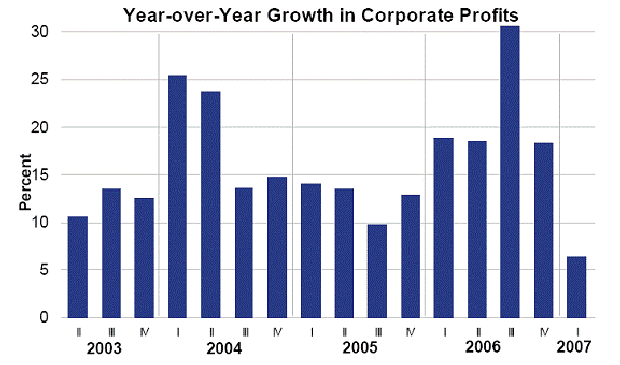
Corporate profits growth is measured as the percent change from the same quarter one year ago.
Bureau of Economic Analysis, U.S. Department of Commerce
Personal Income
A broad current-dollar measure fell 0.1 percent in April, after growing 0.8 percent in March. Wages and salaries, the largest component of personal income, decreased 0.4 percent, after increasing 0.7 percent; the decline in April reflected unusually large bonus payments and exercises of stock options in January through March.
Real disposable personal income (DPI), the after-tax amount available for spending or saving, decreased 0.4 percent, compared with a 0.3 percent increase in March.
Real consumer spending (personal consumption expenditures) increased 0.2 percent in April, after remaining flat in March. Household energy spending picked up after dropping in March.
Prices, as measured by the personal consumption expenditures price index, grew at roughly the same rate in April as in March. Excluding food and energy, prices increased 0.1 percent, after being flat in March.
Personal saving as a percent of disposable personal income was -1.3 percent in April.
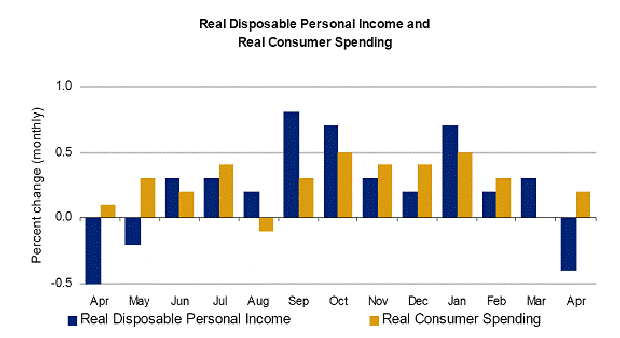
Nonfarm payroll employment increased by 157,000 in May, and the unemployment rate was unchanged at 4.5 percent, the U.S. Department of Labor reported.
Health care and food services added jobs, while employment declined in manufacturing. Average hourly earnings rose by 6 cents, or 0.3 percent, over the month.
In May, the average workweek for production and nonsupervisory workers on private nonfarm payrolls increased by 0.1 hours to 33.9 hours, seasonally adjusted.
The manufacturing workweek and factory overtime each fell by 0.1 hour to 41.0 and 4.1 hours, respectively.
Average hourly earnings of production and nonsupervisory workers on private nonfarm payrolls increased by 6 cents, or 0.3 percent, in May to $17.30, seasonally adjusted.
Average weekly earnings grew by 0.6 percent over the month to $586.47. Over the year, average hourly and weekly earnings rose by 3.8 and 4.1 percent, respectively.
April 2007 Construction Rates
The U.S. Census Bureau of the Department of Commerce announced today that construction spending during April 2007 was estimated at a seasonally adjusted annual rate of $1,190.0 billion, 0.1 percent (±1.3%) above the revised March estimate of $1,188.9 billion.
The April figure is 2.0 percent (±1.9%) below the April 2006 estimate of $1,214.4 billion.
During the first 4 months of this year, construction spending amounted to $345.1 billion, 2.5 percent (±1.8%) below the $353.8 billion for the same period in 2006.

Stocks
The Dow gained 1.2% this past week and is up 9.7% year-to-date.
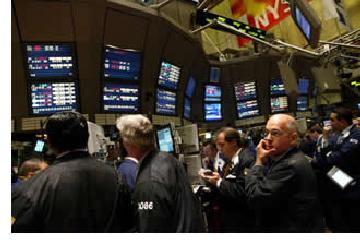 The Transports were up 3.4%, bringing their yearly gain to a very nice 16.8%. The Utilities added 1.4% and are ahead a very respectable 12.1%.
The Transports were up 3.4%, bringing their yearly gain to a very nice 16.8%. The Utilities added 1.4% and are ahead a very respectable 12.1%.
The NASDAQ 100 put in a 2.0% advance and is up just under 10% for the year. The S&P 500 added 1.3% for an 8.3% yearly gain.
Stock markets continue to perform strongly, not just here in the U.S. but essentially around the world, although there are a few weak links: most notable are the oil rich Middle East bourses.
Saudi Arabia's Tadawul All Share Index is down 7.5% this year (2007) after losing over 50% in 2006. This dismal performance is food for thought.
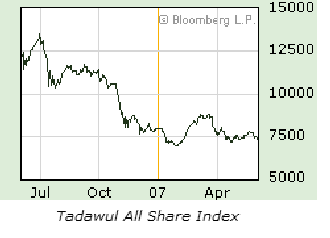 As the economy section at the beginning of the report discussed, the problems in the subprime mortgage market have yet to filter their way completely through and out of the economy. There appears to be more downside risk yet to be manifested in the housing market, especially if long term rates continue to rise as they have been.
As the economy section at the beginning of the report discussed, the problems in the subprime mortgage market have yet to filter their way completely through and out of the economy. There appears to be more downside risk yet to be manifested in the housing market, especially if long term rates continue to rise as they have been.
The next chart indicates that investors are waiting for the other shoe to drop within the housing/lending markets, as it shows the banking industry lagging badly behind the recent record setting performance of the overall stock market. The banking sector is the backbone of the economy, so it is with great interest and wonder that we note this divergence.
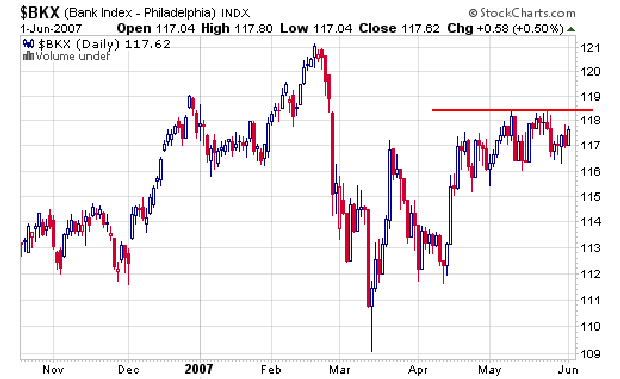
Much talk and discussion is currently focused on China - China this and China that. It is the up and coming new kid on the block, of that there is no doubt. I remember when Japan was in the same position, or so it was thought.
Hong Kong has been a bastion of capitalism in the East as well. China has been a big boost to business and commerce in Hong Kong, and so it is with interest that we note the Hang Sang Index is beginning to show some cracks at the seams.
Also, worthy of mention is that China's CSI 300 stock index fell 10% this past week. Below is the Hang Seng Index.

Bonds
We have said for months that any surprises in the bond market would be to the upside, and so far that is true. Rates have been rising both on the short and the long end of the yield curve.
Higher rates on the long end will further exacerbate the problems in the mortgage lending market, and thus in the housing market and peripheral industries related thereto.
Two-year government yields were up a large 11.5 bps to 4.97%. Five-year yields added an even heftier 12 bps to 4.92%.
The Ten-year Treasury yield added 9.5 bps to 4.95%, and the long-bond yields gained 5.5 bps to 5.06%.
The spread between the 2 year and 10 year closed the week inverted 2 bps. So the Fed has its coveted inverted yield curve still in place, however, rates are rising on both the short and the long end - they have simply moved a bit more on the short end.
As we said, the Fed does not want long term rates to rise, as it will be the death knell to the housing market. It will be fascinating to watch how it all plays out; and whether the Fed can walk the tight rope it has stretched across the abyss. We wish them luck - they will need it.
The first chart up is the 10 Year Treasury Note Yield, followed by the 30 Year Treasury Bond Yield.

As the chart shows, rates have been backing up since March and have now broken through overhead resistance just above 4.9%, closing the week out at 4.956%.
It remains to be seen if resistance broken now becomes support and holds, which will mean rates are headed higher; or whether support will give way to lower rates.
Next is the 30 Year Yield that has been rising as well. It too has broken overhead resistance and closed at 5.062%.
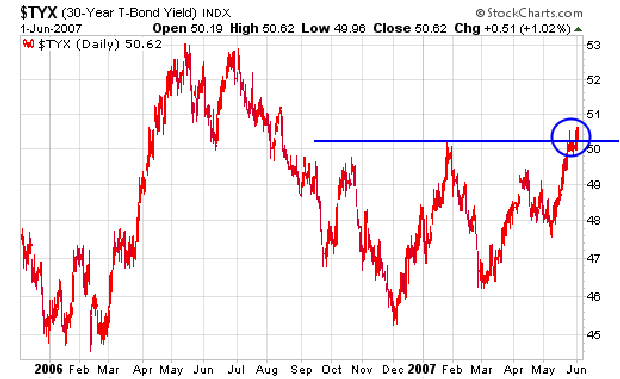
Next we have a chart showing the 10 Year, 30 Year, and 90 Day Interest Rate Yields overlaid one upon another.
The 30 Year is higher than the 10 Year (5.062% compared to 4.956%), both of which are higher than the 90 Day at 4.656%.
Notice, however, that the 90 Day Yield has fallen considerably, while both the 10 Year and 30 Year Yields have risen considerably.
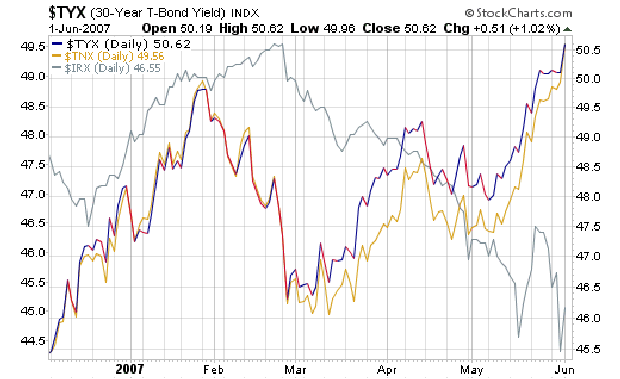
Fed Foreign Holdings of Treasury Debt were up $14.6 billion to a record $1.959 trillion this past week, which is a 28% increase.
Custodial holdings added $345 billion, for a yearly increase of 21.4%. The pumps are primed and pumping 24/7.
Currency
For another week the dollar index hardly budged when all was said and done, closing at 82.32.
 Against the euro the dollar traded at $1.344 per euro, after recently trading at a record low of $1.368.
Against the euro the dollar traded at $1.344 per euro, after recently trading at a record low of $1.368.
The Canadian dollar was up a large 1.8% versus the dollar, closing the week out at 94.23.
It touched 94.33 intraday, the highest level in 30 years.
The dollar climbed 0.2% against the yen, closing the week at 122.07 - a four month high. It reached 122.14 intraweek before backing off.
The yen fell 0.26% versus the euro, closing the week at 164.14 per euro. On May 28th it traded at an all-time low of 164.29 per euro.
The yen has the lowest interest rate (0.5%) of any major world currency. This causes the yen to be heavily borrowed by speculators who then invest in higher yielding instruments.
This is known as the yen carry trade, which is providing a good deal of the excess liquidity that is fueling the many worldwide asset booms.
 Watch the yen carefully, as it will eventually rally up. When it does there will be a great deal of unwinding of huge yen carry trade induced positions.
Watch the yen carefully, as it will eventually rally up. When it does there will be a great deal of unwinding of huge yen carry trade induced positions.
So far this year the yen has fallen against all major world currencies, including 2.5% versus the dollar, and 4.4% versus the euro.
International reserve assets, excluding gold, were up $565 billion to a record $5.37 trillion, a 28% annualized rate of expansion. As the picture shows - they sure know how to print the stuff.
The first currency chart is the U.S. Dollar Index, which shows the dollar has had an oversold bounce from 81.30 to 82.32. More upside is possible; however, note that just above resides overhead resistance, indicated by the yellow highlighted area.
83.57 is the first fib retracement level and is as far as any rally I see occurring, but I've been wrong before and I could be wrong again. One important note: there are a lot of players on one side of the boat. Caveat Emptor, as they are all short the dollar.
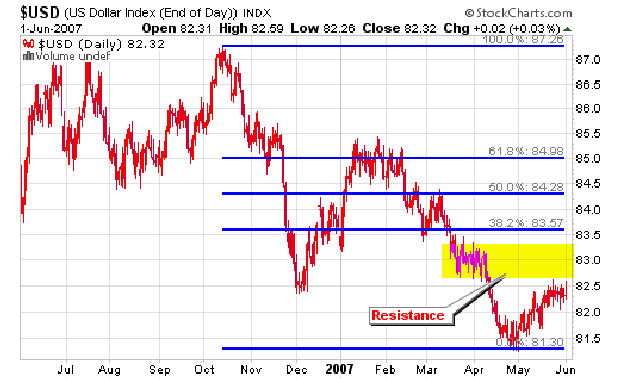
More important than the dollar chart in my opinion is the following chart of the euro. If the bottom trend line holds, then the long term trend of the euro up and the dollar down will continue. I place more emphasis on this chart than on the one above.
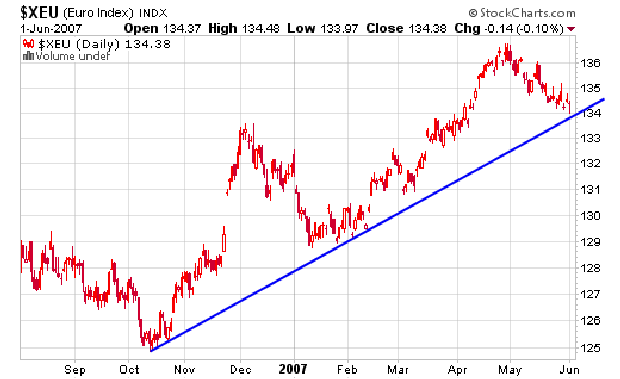
Next up is a chart of the yen. This is THE chart to watch. The yen is THE weakest currency in the world (of the 16 majors). If and when (and there will be a when) the yen rallies - look out, as all those yen carry trades will start to spin like whirling dervishes. It will be quite a show.

Last up for the currency charts is the following chart that shows the euro, dollar, and yen overlaid and compared one to another.
The euro is at the top right corner of the chart (a bullish signature).
The dollar and the yen are competing for the lower right corner of the chart - a bearish signature.
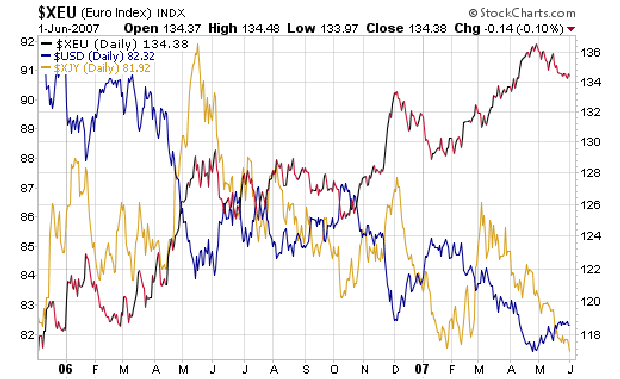
Commodities
Copper gained 2.5% on the week. During the prior three weeks copper lost 12%, yet remains up 18% for the year. If you want to take a good stress test for your heart, try trading copper for a year.
Well, summer driving season is here and the demand for gasoline is high - naturally gasoline supplies are suddenly inordinately low.
There's enough oil to fill up the ocean, but try filling your car up with gas and see the result: higher and higher prices because of some refinery excuse.
But when winter comes, as it always does, there suddenly will be too much gasoline and not enough heating oil. Isn't it kind of funny how that works out so well - for them?
July Gasoline rose 4.14 cents, or 1.9 percent, to close at $2.2446 a gallon. July crude lost 12 cents to $65.08.
 Natural Gas for July delivery fell 5.7 cents, or 0.7 percent, to close the week out at $7.878 per million BTU's.
Natural Gas for July delivery fell 5.7 cents, or 0.7 percent, to close the week out at $7.878 per million BTU's.
First up is the CCI continuous commodity chart. We much prefer this index compared to the CRB index, as the first is unweighted and the second is weighted with a heavy preference to energy.
When someone tells you how bad commodities are doing, show them this chart. It proceeds from the lower left corner to the upper right - about as good as it gets.
Is it topping out? - It could be. Or it could be building a base for the next move up. Time will tell. The blue horizontal line shows overhead resistance that needs to be taken out if another leg up is to occur.
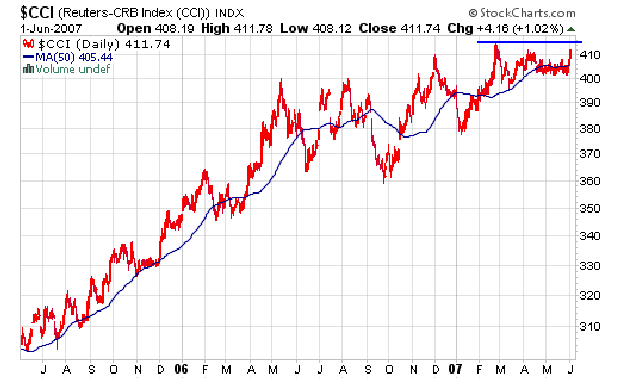
Next up is the daily chart of West Texas Crude (WTIC). It has had a good rally but so far it is a counter trend rally that is meeting resistance at the 50% fib retracement level.
It has done well; however, it will have to do even better to turn the long term trend around. We wouldn't be at all surprised, but it may take a good deal of time.
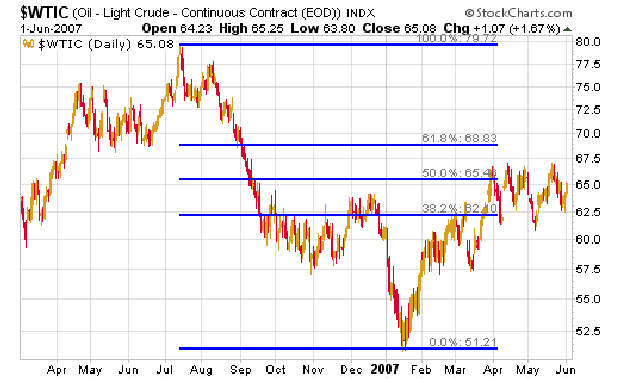

DHAHRAN (Saudi Arabia) -- Saudi Aramco and US Dow Chemical Co. yesterday announced a deal to build a petrochemical plant that industry insiders expect to be the largest foreign investment in Saudi Arabia's energy sector.
Gold
Gold added $15.50 per ounce to close at $676.90 for a +2.34% weekly gain. It was the highest weekly close in the last 4 weeks.
 Friday's closing price was the highest daily close for the week, which is constructive.
Friday's closing price was the highest daily close for the week, which is constructive.
Gold's intraday high was $677.50 on Friday. Its intraday low was $657.70 on Wed.
First up is the daily chart of gold, which shows a very positive development.
Gold closed back up above its lower trend line and within its bullish channel. It has, at least for now, regained some hollowed ground. It remains to be seen if it holds.

MACD, histograms, and RSI all turning up into positive territory. If the action continues up and within the channel - things will be looking good. Before you get to excited, however, let's look at the weekly chart next.
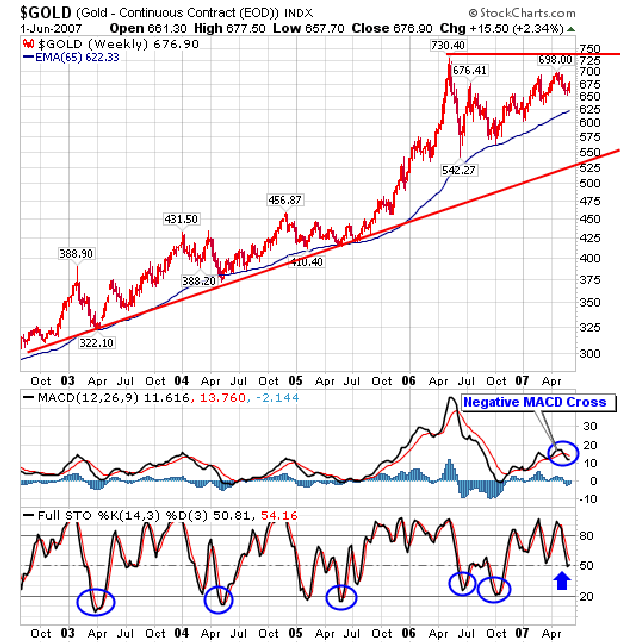
The weekly shows a negative MACD Cross and STO far above the oversold 20 reading. This doesn't mean it has to go to 20 before bottoming, but as you can see - most times it has.
Also, the 65 week ma has acted as strong support all during the bull market, and as you can see it is a ways below - like $54 dollars below.
Once again, this is not precluded or written in stone - but it's been there many times before, and it is what it is - until it isn't. Caveat Emptor.
Next is the monthly chart. The monthly is sending mixed signals. The trend is clearly up as indicated by the rise from the bottom left to the upper right. Gold has remained above its 20 ema the entire course; however, presently it is a ways above - suggesting that perhaps it needs to consolidate some more. Maybe, maybe not. Time will tell.
STO is showing a positive divergence, as it made lower lows while the pog did not. They never make it easy. Heck, it wouldn't be any fun anyways. The contest goes to the brave at heart.

Next we have the daily chart of gold, followed by the daily chart of silver, courtesy of the bullion desk.
Silver has become interesting, and we thought we would lead into the silver chart with the same chart for gold.
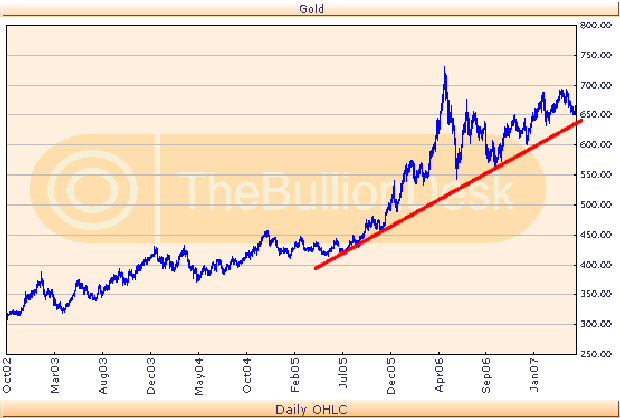
Silver
Silver is holding its trend line, and as the second chart shows, it closed back above its lower trend line, and within its continually compressing triangular formation.

Next is the daily chart of silver. It shows silver closing above its lower trend line that it had previously fallen precipitously below.
Last week we said it had to regain the high ground, and lo and behold it did (at least for now). We also had mentioned that a possible positive MACD cross looked like it might be setting up - and lo and behold it did; all of which makes us a bit nervous.
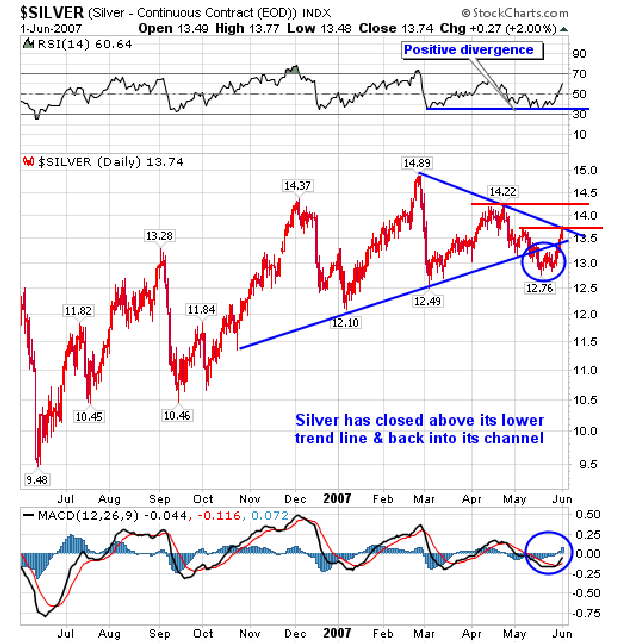
The positive divergence in the RSI mentioned last week seems to have resolved itself to the upside, but it needs to hold this week to know for sure.
The chart looks better this week compared to last, however, there is still much hard work needed to be done.
Below is the gold/silver ratio chart, which compares the performance of gold with that of silver. There have been times during the pm bull market where gold has been the stronger and other times when silver has been stronger.
For the recent short term time frame, gold has been out performing silver, however, that trend may be changing, as the ratio just broke below 50, which strongly suggests silver is going to out perform near term.

The silver ishares (SLV) exchange traded fund (ETF) has also broken back above its lower trend line support it had recently breached.
The chart has a number of positives going for it, as not only was the lower trend line broken above, but the 50 ma was broken through and above; a positive MACD Cross Over occurred; histograms turned up and positive; and volume expanded, as not only indicated by the daily volume, but by the on line balance volume indicator as well, which is bumping up against significant resistance that if broken above will be very bullish. The operable word being if.
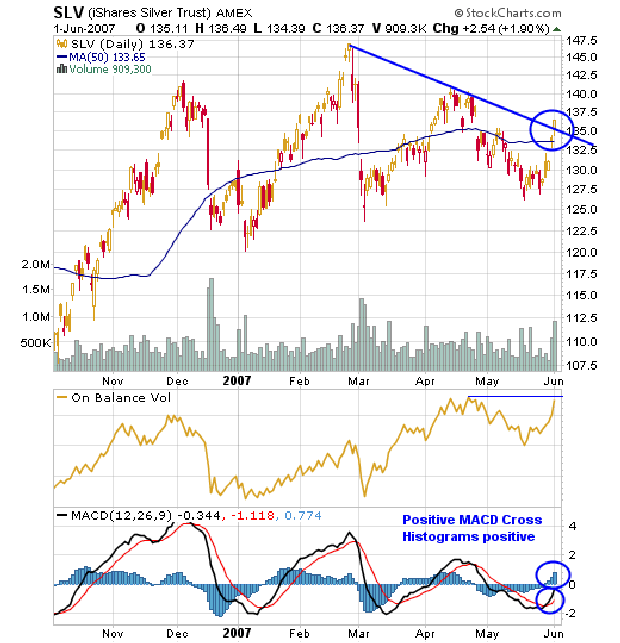
StreetTracks Gold ETF also put in a good performance, but not quite as strong as silver's.
The 50 ma is just being bumped up against, not yet broken above. MACD and the histograms have just barely turned up.
Volume picked up but not as much as silver's, as the on line balance volume indicator is a ways below its overhead resistance above.
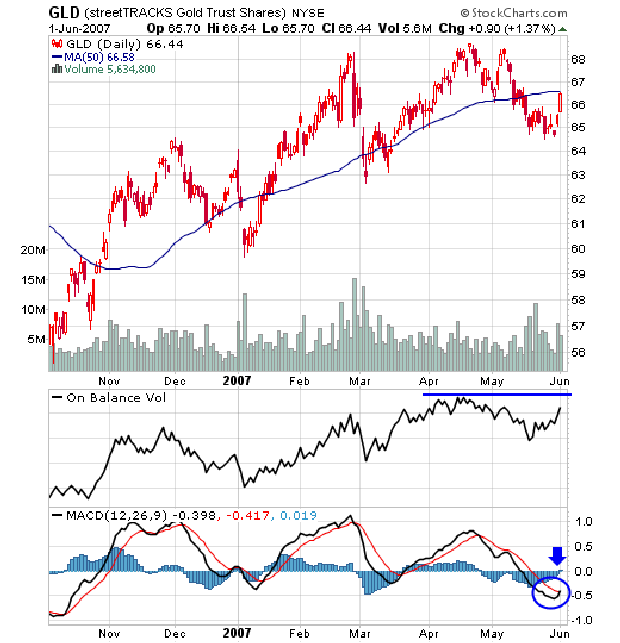
Gold & Silver Stocks
We have seen that gold and silver had a pretty good week, but remember - that's partially because they have had some pretty awful weeks. That is not meant to diminish the price action, just to keep it in its proper perspective.
The gold and silver stocks had an even better week compared to the metals, which is a very constructive positive divergence. The pm market is always strongest when both the stocks and the metals are advancing together, with the stocks advancing the strongest (at about a 3 to 1 ratio to the metals).
First up we will look at the GDX daily chart. The index was up 1.80 to 40.06 for a +4.70% weekly gain. It's bumping up against its 50 dma but didn't close above it.
MACD made a positive cross over and histograms turned up and positive as well. Volume increased strongly. That is most positive. The on line balance volume broke above its falling upper trend line.
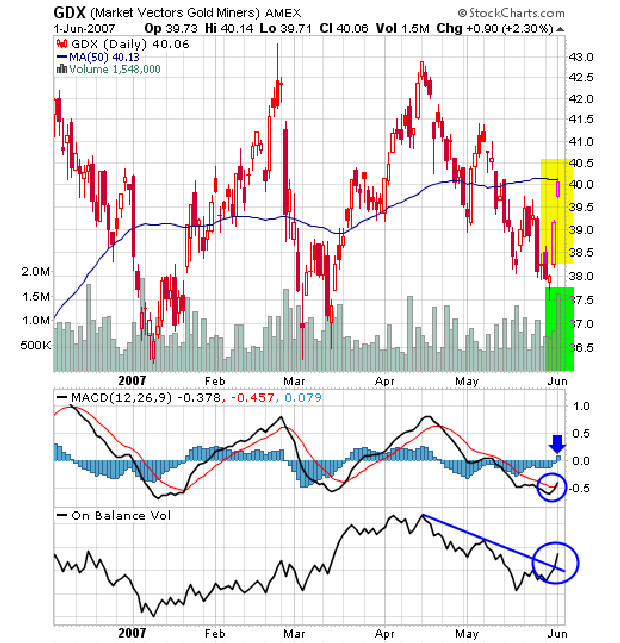
Below is the point & figure of the GDX, which shows a bullish price projection of 56 (presently at 40).
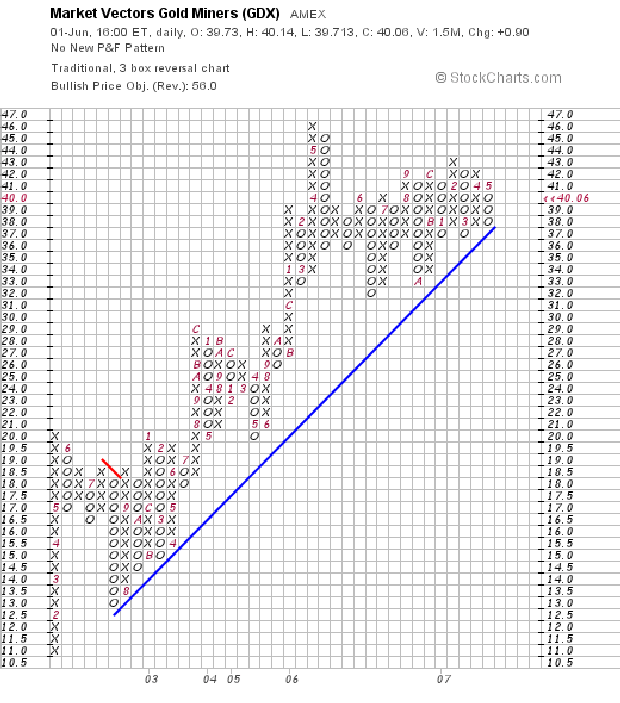
XAU Index
Next we turn our attention to the Xau Index. First is the daily chart. For the week the Xau closed up 6.62 points to 142.42 for a +4.87% gain. It was the highest weekly close in the past six weeks and the highest daily close of the week.
The index closed back above its 50 ma, made a positive MACD cross over, histograms have turned positive, and the xau/gold ratio is just peaking above its trend line - all positive and constructive developments.
Last week we mentioned that these were some of the markers that needed to be put in place if any chance of a sustainable rally were to occur.
As fortune would have it - the gods have smiled, at least for the time being. It remains to be seen their mood next week. The gods can be very fickle if you haven't noticed.

The next overhead resistance targets are indicated by the series of three red and blue horizontal lines.
Next is the weekly chart of the Xau, which shows it is sitting smack dab in the middle of its recent trading range from 130 to 150. A break above 150 would be very bullish.

 Below is the monthly chart of the Xau. It too shows the index sitting in the middle of its recent trading range.
Below is the monthly chart of the Xau. It too shows the index sitting in the middle of its recent trading range.
The negative MACD cross is still dominating the chart and needs to be turned back up.
A new positive development is a break above its upper falling trend line by the xau/gold ratio.
There is still a good deal of work that needs to be done to turn the chart bullish, but progress is slowly being made.
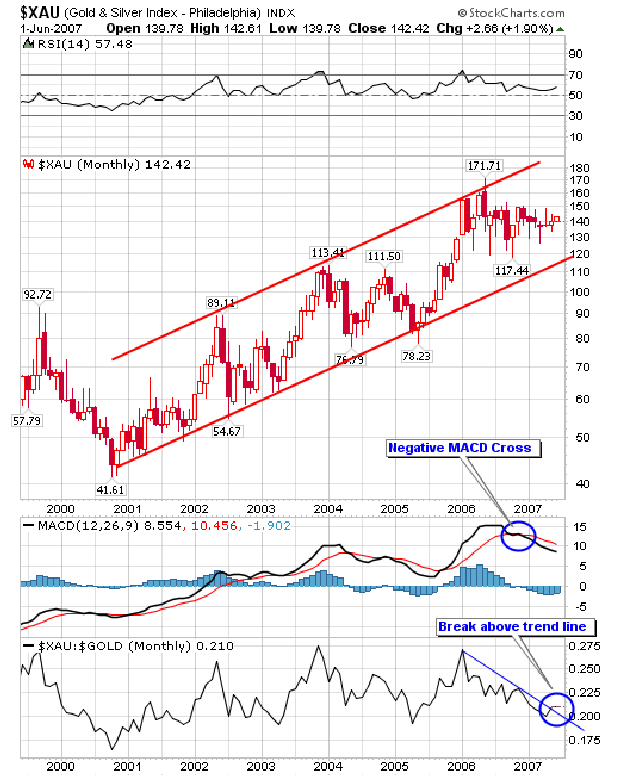
XAU/Gold Ratio
Next we're going to look at a couple of charts comparing the xau to gold. Both are daily charts.
The first chart covers a bit more time and shows the declining trend of the performance of the Xau compared to gold.
The second chart hones in on the overhead resistance levels, which if breached to the upside would be very bullish.
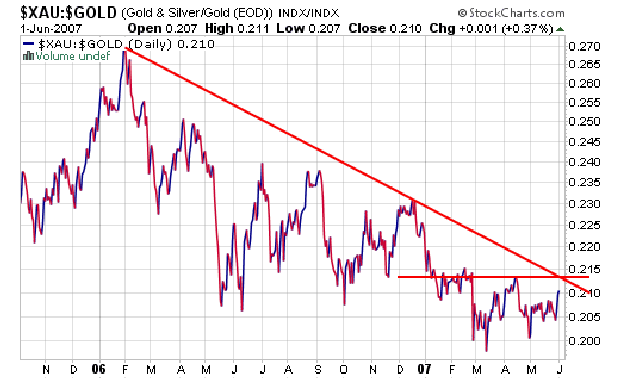
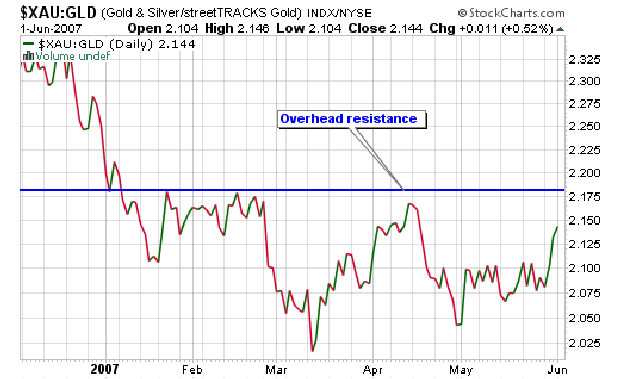
HUI Index
The Hui Index had a good week, closing up 20.59 points to 342.84 for a gain of +6.39%. It was the highest weekly close going back 4 weeks.
Friday's weekly close was the highest daily close of the week. The intraday high for the week was 344.07, and the intraday low for the week was 317.70.
The first chart we would like to show is the point & figure chart, which shows a double top breakout on Friday June 1, 2007. The preliminary price objective is 396. As always, follow through confirmation is needed.
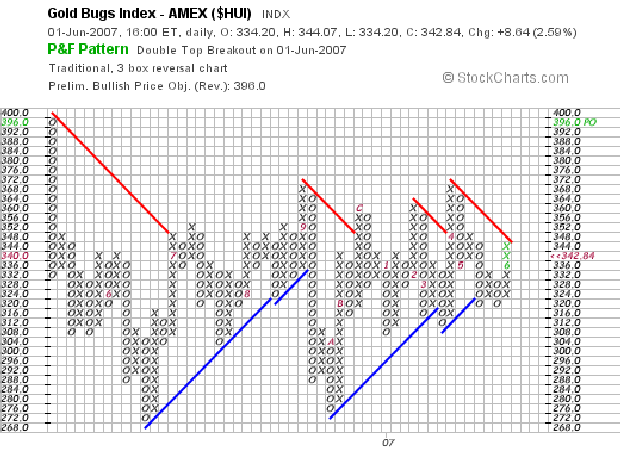
Next is the daily chart of the Hui Index. It shows the Hui just peaking above its 50 ma. Histograms have turned up and positive, and the positive MACD cross we said appeared to be looming last week was actually fulfilled by whoever fulfills such things.
The chart looks much better compared to recent weeks, but there is still much work to be done.

The weekly chart shows the index breaking back above its lower trend line and back into its symmetrical triangle formation. Also, the index is above its 65 ema.
A negative MACD cross is still the dominant chart feature, and histograms are below zero but may be getting read to move up.
Has STO gone low enough for a bottom, and is that the beginning of a turn upwards that will last? More clues should be forthcoming this week.
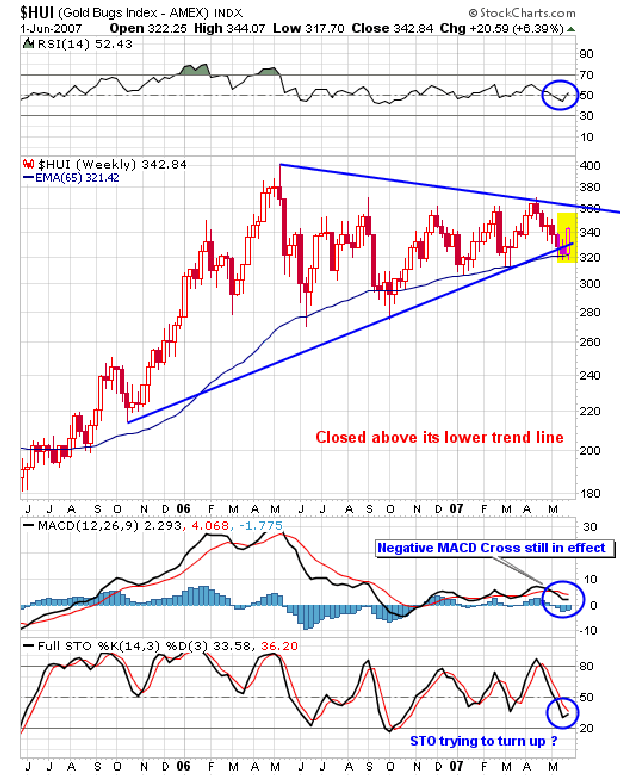
Next we have the monthly chart. The negative MACD cross and histograms below zero are the dominant chart features. The index still remains well above its 20 ema.
The question is - is the sideways action a top forming, or a base for a new leg up?
As of now we lean to the latter, although the rally occurring that we had thought, and said might occur, is not as of now, considered to be part of the next major leg up in the golden bull market.
It may very well develop into that but as of now that's not how we see it. We'll just take it one step at a time.
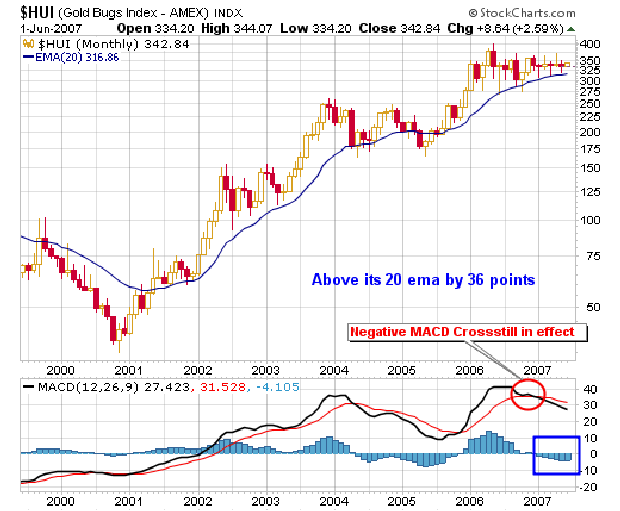
Next is our favorite chart of the Hui/Gold ratio. It's a daily chart that goes back for about a year. The blue circles indicate where previous lows in the ratio lined up with lows in the Hui.
The vertical lines connect the lows in the Hui/Gold ratio to the lows in the Hui at the bottom of the chart.
The present level for the Hui/Gold Index strongly suggests that we are at or near a bottom formation.

Summary
Real disposable personal income (DPI), the after-tax amount available for spending or saving, decreased 0.4 percent.
Real consumer spending (personal consumption expenditures) increased 0.2 percent in April.
Personal saving as a percent of disposable personal income was -1.3 percent in April.
What does the above statistics say?
Consumer spending was up 0.2%, while real disposable income was down 0.4%. If consumer spending is increasing faster than consumer income (which it is) then where is the money coming from to pay for the increase in spending?
It is coming out of savings, which is why the savings rate is down to a negative -1.3% rate, meaning that consumers are going into more debt to sustain their buying or consumption. This is a prescription for trouble round the corner. Caveat Emptor.
The housing market is feeling the pain and there is yet more to come, as personal bankruptcies are up 35%, and the banking index can't get out of its own way.
Stock markets here and abroad continue to float up on a sea of liquidity. It is an asset bubble of huge proportions that will not be pretty when it stops.
Bond and interest rates are steadily rising. The Fed once again has its coveted inverted yield curve, where short term rates are above long term rates. However, the long end continues to rise. Higher long term rates will be devastating to the housing market.
Watch the euro to see if its trend line holds (which we expect), and watch the yen for any rise, as such will be a shot across the bow of trouble to come in the yen carry trade and the derivatives associated therewith.
Commodities are still running strong and may have a correction and or consolidation coming before resuming their move up.
The precious metal sector had a good week, with physical and the stocks up. The pm stocks out performed the metal, which is a constructive development. Now they need to hold and further their advance. There is much work to be done before a meaningful and sustainable rally can occur.
We are of the opinion that there is more to come in the pm rally, especially in the stocks; however, as of now we do not consider this rally to be the beginning up the next major leg up. It could develop into that, but as of now it doesn't appear to be.
In closing I would like to mention the Presidential election that looms large on the horizon. From all but one candidate - the script remains the same: more script or debt, and more fighting to promote U.S. imperialism, and from that a New World Order.
Our constitutional rights are being stolen daily, right beneath or noses. We all need to wake up before there is nothing left to wake up to - except a life of debt servitude.
There is only one candidate that speaks from his heart, that knows from whence he speaks, that puts the Constitution before all else except the sovereign people of our nation. His name is Congressman Ron Paul from Texas. Check him and his message out.
If you want truth, if you want liberty, if you want to end fighting needless wars , and stop spending billions and billions of dollars in the most wasteful spending orgy known to mankind - then vote for Congressman Ron Paul, a candidate with a vision - a vision of freedom, liberty, and the pursuit of happiness.
We can cultivate this:

Or this:

Invitation
Stop by our website and check out the complete market wrap, which covers most major markets. There is also a lot of information on gold and silver, not only from an investment point of view, but also from its position as being the mandated monetary system of our Constitution - Silver and Gold Coins as in Honest Weights and Measures.
There is also a live bulletin board where you can discuss the markets with people from around the world and many other resources too numerous to list. Drop by and check it out. Good luck. Good trading. Good health. And that's a wrap.
Come visit our new website: Honest Money Gold & Silver Report
Douglas V. Gnazzo
Honest Money Gold & Silver Report
Douglas V. Gnazzo is the retired CEO of New England Renovation LLC, a historical restoration contractor that specialized in the restoration of older buildings and vintage historic landmarks. Mr. Gnazzo writes for numerous websites, and his work appears both here and abroad. Just recently, he was honored by being chosen as a Foundation Scholar for the Foundation of Monetary Education (FAME).
Disclaimer: The contents of this article represent the opinions of Douglas V. Gnazzo. Nothing contained herein is intended as investment advice or recommendations for specific investment decisions, and you should not rely on it as such. Douglas V. Gnazzo is not a registered investment advisor. Information and analysis above are derived from sources and using methods believed to be reliable, but Douglas. V. Gnazzo cannot accept responsibility for any trading losses you may incur as a result of your reliance on this analysis and will not be held liable for the consequence of reliance upon any opinion or statement contained herein or any omission. Individuals should consult with their broker and personal financial advisors before engaging in any trading activities. Do your own due diligence regarding personal investment decisions. This article may contain information that is confidential and/or protected by law. The purpose of this article is intended to be used as an educational discussion of the issues involved. Douglas V. Gnazzo is not a lawyer or a legal scholar. Information and analysis derived from the quoted sources are believed to be reliable and are offered in good faith. Only a highly trained and certified and registered legal professional should be regarded as an authority on the issues involved; and all those seeking such an authoritative opinion should do their own due diligence and seek out the advice of a legal professional. Lastly, Douglas V. Gnazzo believes that The United States of America is the greatest country on Earth, but that it can yet become greater. This article is written to help facilitate that greater becoming. God Bless America.
© 2005-2022 http://www.MarketOracle.co.uk - The Market Oracle is a FREE Daily Financial Markets Analysis & Forecasting online publication.



